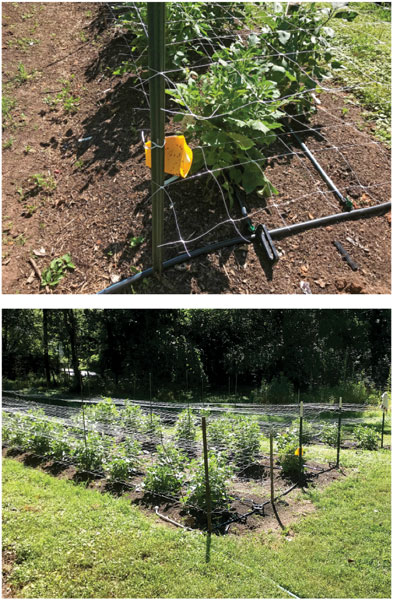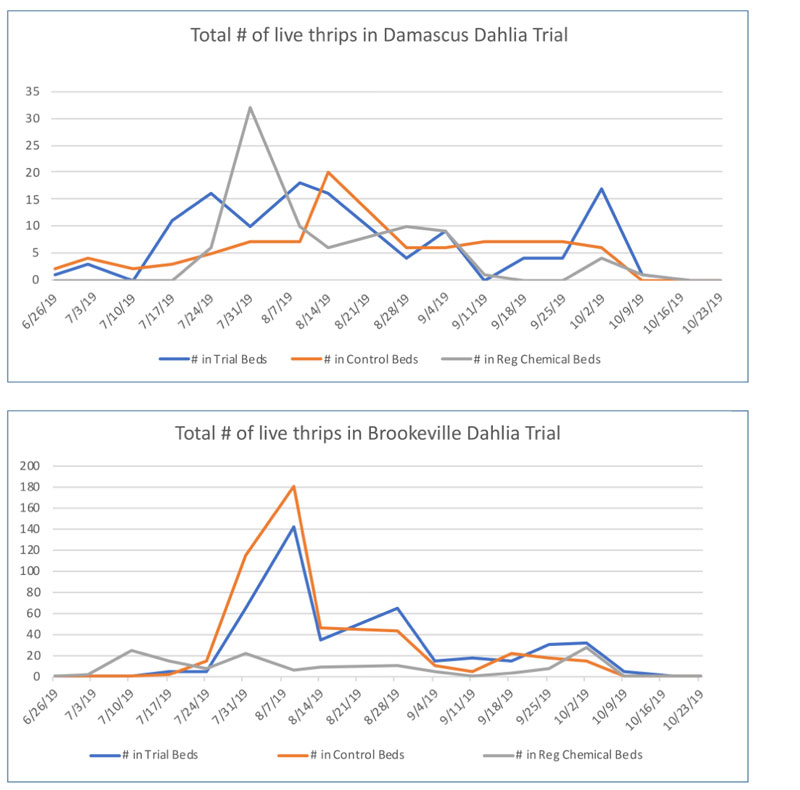1/1/2021
Major Insect Pests of Dahlias
Stanton Gill, Nancy Rechcigl, Suzanne Klick & Heather Zindash

The purpose of our field trials was to evaluate if the use of systemic insecticide drenches can be combined with release of insect predators and use of banker plants to deal with major insect and mite problems associated with growing dahlias plants. Thrips, aphids, Tetranychid mites, corn borers and cucumber beetles are just a few of the pests that prefer to not share the dahlia flowers with growers. These plots were compared to plots treated with conventional chemical treatments.
In 2018, we initiated the first year of a field trial to evaluate use of low-risk systemic chemical applied as a soil drench combined with release of two predators to suppress damage from thrips. In the first year of the trial, it basically rained each week during the growing season, sometimes multiple incidences, from March through November, often with heavy downpours. Results of this trial were published in the March 2019 issue of GrowerTalks.
Pictured: Food and pheromone-baited yellow trap to attract cucumber beetles.
Biocontrol dahlia plots in mid-summer 2019.
In 2019, the weather started out rainy with record levels of rain in May, followed by regular weekly rains in June and early July. In late July, the weather switched to a dry, low humidity situation with no rains until October. These two contrasting seasons were a good test of our project in various weather conditions. In wet spring, aphids often build up rapidly. We noticed predators and parasites reduced much of their activity in rainy weather. Spider mites thrive in hot, sunny weather and fare poorly in wet seasons.
In each year, the goal was to keep insect and mite damage below a threshold that allowed the dahlia plants to produce flowers that would be used in dahlia judging events. At both sites, we had three plots—one with the systemic insecticide applied combined with the predator releases, a second plot in which the growers used conventional insecticide and miticide sprays, and a third plot that was an untreated control. Before we started the trial, the two growers had reported two-spotted spider mites as a continual problem on dahlia crops.
The frequent and heavy rains of 2018 and the first half of 2019 kept the spider mite population low with no measurable activity detected on the biological and systemic plots. Spider mites were also not detected on the standard chemical-treated plots.
Two field test sites were used—one in Brookeville, Maryland (Heritage Roses), and the second in Damascus, Maryland (Crazy 4 Dahlias). The sites were monitored on a weekly basis by Heather Zindash (Independent IPM Scout) and Suzanne Klick (Lead Technician from our CMREC University of Maryland facility).
Background of the project
In the spring of 2018, Nick Weber of the Maryland Dahlia Society asked us to develop an IPM approach for dealing with insect and mite pests of dahlia plantings. Over the years, we’ve developed many biological control programs for greenhouse crops with good success rates. We decided that a combination of systemic chemical and biological control releases could work well.
Working closely with Nancy Rechcigl of Syngenta, Bell Nursery of Burtonsville, Jan Meneley of AgBio, and Koppert Company, we analyzed several products before settling on the use of Mainspring drenches applied twice during the year combined with predacious mite releases, banker plants, release of predacious insects, and pheromone and food-baited sticky traps.
Methods
The first step was obtaining seed of an ornamental pepper called Purple Flash. (We used Purple Flash since it has blooms continually during the growing season.) These pepper plants were used as banker plants to produce pollen and nectar to feed a predacious bug, Orius insidiosus (minute pirate bug), used to control thrips. The seeds were turned over to Bell Nursery in March to start growing the pepper plants. Pepper plants are slow to get going and we needed them in bloom by mid-summer, so 70 to 90 days was allotted to have them in bloom for when the dahlias came into bloom and attracted adult thrips to the blooms.
The dahlia tubers were planted at two sites: one in Brookeville (Heritage Rosarium owned by Nick Weber) and the other in Damascus (owned by John Spangenburg). At both sites, the tubers were planted in late May of 2019. There were three plots at each site: systemic insecticide and biological control releases, conventional chemical treatment, and control blocks of plants.
On the systemic/biological control-treated blocks, we made a soil drench of Mainspring at a rate of 8 oz./100 gallons of water. Each plant was drenched at the base with 8 oz. (237 ml or 0.24 l) of prepared liquid solution. Syngenta advised that this would supply 12 weeks of control. A second application at similar rates was made 12 weeks after the first application.
Mainspring GNL is a suspension concentrate (SC) formulation containing 1.67 pounds of cyantraniliprole per gallon. Cyantraniliprole belongs to the anthranilic diamide chemical class, introducing a new class of chemistry in IRAC Group 28 to ornamental insect control. Mainspring quickly stops insect feeding after ingestion and it’s compatible with many beneficial insects and mites.
 This Mainspring application provided protection from aphids and thrips feeding on foliage, and corn borer that feed on dahlia stems. The two common species of aphids found on dahlias are green peach aphid and melon aphid. Plants were monitored on a weekly basis and no aphids were detected in the first 12 weeks of growth. Aphids weren’t found on Mainspring-treated plants after the second drenching, but aphids weren’t found on control plants or conventional chemical-treated plants in 2019. Also, no thrips populations were found on treated plants.
This Mainspring application provided protection from aphids and thrips feeding on foliage, and corn borer that feed on dahlia stems. The two common species of aphids found on dahlias are green peach aphid and melon aphid. Plants were monitored on a weekly basis and no aphids were detected in the first 12 weeks of growth. Aphids weren’t found on Mainspring-treated plants after the second drenching, but aphids weren’t found on control plants or conventional chemical-treated plants in 2019. Also, no thrips populations were found on treated plants.
We obtained Amblyseius cucumeris mites, a predatory mite that feeds on thrips nymphs. This species of predatory mites has been used for prevention, control and maintenance of various thrips species with good success in greenhouse operations. The mites use sucking mouth parts to pierce and ingest contents of their prey. We used A. cucumeris in small sachets since sprinkling predatory mite in a grain mix onto dahlia foliage and flowers was objectionable to the growers. Each paper sachet contains 1,000 predatory mites and grain mites (all stages), mixed with bran.
A. cucumeris performs best at temperatures under 90F. Normally in Maryland, it reaches these temperatures in July and August, so we switched to the predacious mite Amblyseius swirskii, which performs better at higher temperatures. This mite is about two to three times the cost of A. cucumeris. On July 26, we switched to A. swirskii LP sachets and made three releases every two weeks. We didn’t release A. swirskii in 2019 since summer temperatures were below normal and the A. cucumeris mite continued to be active and minute pirate bug was very active. This helped keep expenses down in 2019.
For the Orius releases
Materials used: Two 100 mL bottles containing 1,000 minute pirate bugs, which were sprinkled on each Purple Flash Pepper plant at both sites in 2019 on July 26. They established well on the banker plants and were detected in the flowers of the dahlias shorty after release and were active throughout the rest of the season.
In June of 2019, a fleahopper, Halticus sp., showed up on weeds adjacent to one of the biological control plots at the Brookeville site. The fleahopper migrated into the dahlias and caused damage to the lower foliage of the plants. The Mainspring didn’t provide protection from this pest. We had to make applications of a low-risk material (Altus from Bayer) to control this pest outbreak.
Summary
Mainspring (cyantraniliprole) at 8 oz./100 gallons of water applied as a soil drench was excellent in controlling the aphids on the treated plants and provided control for the whole growing season in both 2018 and 2019. The Mainspring drench applications didn’t impact predator releases of the predacious mites or Orius released during our study. The season of 2018 had record amounts of rain both in frequency and abundance and the spring of 2019 had above-normal rainfall until the mid-summer. This generally suppressed both Tetranychid mite (two-spotted spider mites) and thrips activity in the growing season.
The dahlias in the biological control/systemic chemical control area had a greater number of blooms and thus had a slightly higher population of thrips in blooms. The thrips population remained low on the conventional-treated plants, and the plants that were treated with chemical and biological control.
The banker plants did well and the Orius populations after the initial release remained active throughout the season. In 2018, we switched from releasing A. cucumeris in mid-summer to releasing A. swirskii. A. swirskii performs better in higher temperatures and we expected normal high temperatures July through September. A. swirskii cost about three times the cost of A. cucumeris.
We encountered a pest during the study that we hadn’t anticipated: spotted cucumber beetle. Working with Jan Meneley of AgBio, we evaluated a yellow sticky card baited with pheromone and essence of cucumber extract. In both years, these cucumber beetle sticky traps with lures only caught a few cucumber beetles, but attracted a large number of non-target insects, including syrphid flies, long-legged flies, ladybird beetles and butterflies.
The quality of the plants and flowers were equally high on the conventional and biological/systemic chemical-treated plants. GT
Stanton Gill is Extension Specialist in IPM for Greenhouses and Nursery at the Central Maryland Research and Education Center for the University of Maryland Extension, and Professor at Montgomery College. He can be reached at Sgill@umd.edu or (410) 868-9400; Extension.umd.edu/ipm. Nancy Rechcigl is a technical services manager for ornamentals for Syngenta. Suzanne Klick is Lead technician at the Central Maryland Research and Education Center for the University of Maryland (sklick@umd.edu). Heather Zindash is an independent IPM Scout who owns a company called Soulful Gardener (Heather.zindash@gmail.com).